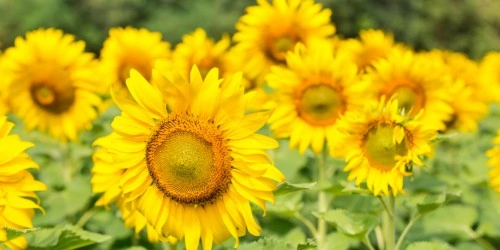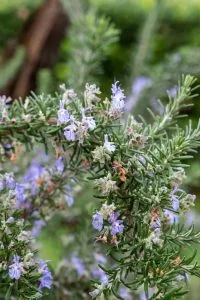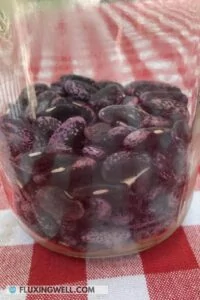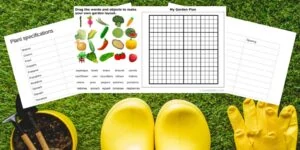Table of Contents
The Sunflower Planting Backstory in Our Garden
I love growing sunflowers. When our boys were younger, I would even grow a sunflower “house” in our vegetable garden by planting sunflowers in a circle.

These days, I have to work a little harder to grow sunflowers due to some squirrel-attracting actions in our rural neighborhood. It’s so worth it. My favorite strategies involve bird netting and a great sunflower companion plant, corn. Sunflowers make great annual additions to our vegetable/cutting garden as well as mixed in with perennials in borders. Let me share a little of my sunflower love with you.
Where is the Best Place to Plant Sunflowers?
Sunflowers are sun-loving plants that require plenty of sunlight to grow and thrive. Here are some tips on the best place to plant sunflowers:
Full sun: Sunflowers need at least 6-8 hours of direct sunlight each day, so choose a spot that receives full sun throughout the day. If possible, choose a location that faces south or west for maximum sunlight exposure.
Well-draining soil: Sunflowers prefer well-draining soil that is rich in organic matter. Avoid planting in heavy clay soils or areas that are prone to standing water.
Wind protection: Sunflowers can grow tall and top-heavy, so it’s important to plant them in an area that is protected from strong winds. Planting them near a fence, wall, or other structure can help provide support.
Adequate space: Sunflowers can grow quite large, so make sure to plant them with plenty of space between each plant. The exact spacing will depend on the variety of sunflower you are growing, but a general rule of thumb is to space them about 1-2 feet apart.
Frost-free area: Sunflowers are sensitive to frost, so make sure to plant them after the last frost date in your area. In colder climates, you may need to start the seeds indoors or wait until the soil has warmed up sufficiently in the spring.
Basically, the best place to plant sunflowers is in a location that receives full sun, has well-draining soil, is protected from strong winds, and has plenty of space for the plants to grow. With the right conditions, sunflowers can grow up to 10 feet tall and produce beautiful, vibrant flowers.
When is the Best Time to Plant Sunflowers?
The best time to plant sunflowers will depend on your location and climate. In general, sunflowers are warm-season plants that prefer soil temperatures between 55-65°F (13-18°C) and require at least 6-8 hours of direct sunlight each day. Here are some guidelines for planting sunflowers:
Spring planting: In most areas, the best time to plant sunflowers is in the spring after the danger of frost has passed and the soil has warmed up. This is typically in late April or early May, but it can vary depending on your location.
Summer planting: If you live in a warm climate with a long growing season, you can also plant sunflowers in the summer. However, be aware that hot temperatures and lack of moisture can cause the plants to wilt or develop fungal diseases.
Fall planting: In some areas with mild winters, you can plant sunflowers in the fall for a late-season crop. Planting should be done at least 100 days before the first frost to allow the plants enough time to mature.
It’s important to note that sunflowers are sensitive to frost and cold temperatures, so it’s important to plant them after the last frost date in your area. If you live in a cooler climate, you may need to start the seeds indoors or wait until the soil has warmed up sufficiently in the spring.
Why are Sunflowers Good Companion Plants?
Sunflowers are considered good companion plants for a variety of reasons:
Pest control: Sunflowers are known to attract beneficial insects like ladybugs, lacewings, and parasitic wasps, which prey on common garden pests like aphids, caterpillars, and whiteflies. In this way, planting sunflowers can help control pests in your garden and reduce the need for pesticides.
Soil improvement: Sunflowers have long taproots that can penetrate deep into the soil, which helps break up compacted soil and improve drainage. When the plants die back, the roots decompose and add organic matter to the soil, which can improve soil fertility.
Shade tolerance: Some crops, like lettuce and spinach, prefer partial shade to full sun. Sunflowers can provide temporary shade for these plants during the hottest part of the day without competing for water and nutrients.
Aesthetics: Sunflowers are tall, showy plants that can add visual interest to a garden and attract pollinators like bees and butterflies. They can also serve as a windbreak or screen for other plants in your garden.
Which Flowers Grow Well with Sunflowers?
Sunflowers can make great companion plants with a variety of flowers that have similar growing requirements. Here are some flowers that grow well with sunflowers:
Marigolds: Marigolds are easy to grow and are known to repel pests like nematodes and whiteflies. They also have bright, cheerful flowers that can complement the large, showy sunflowers.
Zinnias: Can zinnias and sunflowers grow together? Zinnias are another easy-to-grow annual flower that come in a wide variety of colors and can add visual interest to a garden. They prefer full sun and well-draining soil, making them a good companion plant for sunflowers.
Cosmos: Cosmos are tall, airy flowers that come in shades of pink, white, and purple. They attract butterflies and other pollinators and can add a nice contrast to the large, solid-colored sunflowers.
Nasturtiums: Nasturtiums are edible flowers that have a spicy, peppery flavor. They can be planted around the base of sunflowers to add color and attract pollinators.
Roses: Can you plant roses and sunflowers together? Yes, you can plant roses and sunflowers together. In fact, sunflowers can make a great companion plant for roses. Sunflowers attract beneficial insects like ladybugs and lacewings, which can help control pests like aphids and spider mites that can damage roses. Additionally, sunflowers can provide shade for the base of the rose plant, helping to keep the soil cooler and moist, which can be beneficial for the rose plant’s roots. However, it’s important to keep in mind that sunflowers can grow quite tall and may shade the roses too much if not properly spaced. You’ll want to make sure to plant the sunflowers on the north or west side of the rose plant, and leave enough space between the two plants to avoid competing for nutrients and water.
Salvia: Salvia is a drought-tolerant plant that comes in a variety of colors, including blue, purple, and red. It is attractive to hummingbirds and can complement the tall, upright form of sunflowers.
Which Fruits Grow Well with Sunflowers?
Sunflowers can make great companion plants with many types of fruit trees and berry bushes. Here are some fruits that grow well with sunflowers, and this makes me feel great because we already grow these on our small farm:
Apples: Apple trees need full sun to thrive, so sunflowers can help provide some shade during the hottest part of the day. Sunflowers can also attract beneficial insects that prey on pests that can damage apple trees.
Grapes: Grapes also need full sun and well-draining soil to grow well. Sunflowers can provide temporary shade for young grapevines and can attract pollinators like bees that are needed for fruit production.
Blueberries: Blueberries prefer acidic soil, which can be challenging to maintain in some areas. Sunflowers can help by providing some shade and by adding organic matter to the soil as they decompose.
Raspberries: Raspberries are a low-maintenance fruit that can be grown as a hedge or trained onto a trellis. Sunflowers can provide some support for raspberry canes and can attract beneficial insects that help control pests.
Strawberries: Strawberries are a small fruit that can be grown in containers or in the ground. Sunflowers can provide some shade for strawberry plants during the hottest part of the day and can attract pollinators that are needed for fruit production.
Which Herbs Grow Well with Sunflowers?
Sunflowers can make great companion plants with a variety of herbs that have similar growing requirements. Here are some herbs that grow well with sunflowers:
Basil: Basil is an annual herb that is easy to grow and prefers full sun. Sunflowers can provide some temporary shade for young basil plants and can attract beneficial insects like bees that can help with pollination.
Rosemary: Rosemary is a woody perennial herb that prefers well-draining soil and full sun. Sunflowers can provide some shade during the hottest part of the day and can attract beneficial insects that help control pests.
Sage: Sage is another woody perennial herb that is drought-tolerant and prefers full sun. Sunflowers can provide some support for sage plants and can attract beneficial insects that help control pests.
Thyme: Thyme is a low-growing perennial herb that prefers full sun and well-draining soil. Sunflowers can provide some shade for young thyme plants and can attract beneficial insects like bees and hoverflies.
Chamomile: Chamomile is an annual herb that prefers full sun and well-draining soil. Sunflowers can provide some shade for young chamomile plants and can attract beneficial insects like hoverflies and parasitic wasps that help control pests.
Which Vegetables Grow Well with Sunflowers?
Can you plant sunflowers near vegetables? Sunflowers can make great companion plants with many types of vegetables. Here are some great sunflower companion vegetables:
Corn: When our little corn seedlings were struggling to survive like our little sunflower sprouts, we grew them together underneath a tent made of bird netting. Once the plants were about a foot tall, we removed the bird netting and let them grow. They just needed a little help and protection to get started, then they supported each other as they increased in size.
Tomatoes: Tomatoes need full sun and well-draining soil to grow well. Sunflowers can provide some temporary shade for young tomato plants and can attract beneficial insects like bees that can help with pollination.
Cucumbers: Cucumbers also need full sun and well-draining soil to grow well. Sunflowers can provide some support for cucumber vines and can attract beneficial insects like bees and ladybugs that help control pests.
Squash: Squash is a warm-season vegetable that needs full sun and well-draining soil to grow well. Sunflowers can provide some support for squash vines and can attract beneficial insects like bees and predatory wasps that help control pests.
Beans: Beans are a legume that can fix nitrogen in the soil, which can benefit sunflowers and other plants. Sunflowers can attract beneficial insects like bees that can help with pollination.
Peppers: Peppers need full sun and well-draining soil to grow well. Sunflowers can provide some temporary shade for young pepper plants and can attract beneficial insects like bees and predatory insects that help control pests.
Carrots, beets, and turnips are root crops with long taproots. They make good sunflower companion plants because they are resistant to sunflower allelopathy, which is discussed further on down.
Where is the Best Place to Plant Sunflowers in a Vegetable Garden?
When planting sunflowers in a vegetable garden, it’s important to consider their height and size, as well as their effect on the other plants. Here are some tips for where to plant sunflowers in a vegetable garden:
Choose a sunny location: Sunflowers need at least 6-8 hours of direct sunlight per day to grow well. Look for a location in your garden that gets plenty of sun throughout the day.
Plant at the back of the garden: Sunflowers can grow quite tall, so it’s best to plant them at the back of the garden where they won’t shade out other plants. We like to plant our sunflowers on the north side so the do not block the sun from other plants.
Consider the spacing: Sunflowers need to be spaced at least 1-3 feet apart depending on the variety. Be sure to leave enough space between the sunflowers and other plants in your garden.
Plan for wind protection: Sunflowers can act as a windbreak for more delicate plants in your garden, but they can also be damaged by strong winds. Consider planting sunflowers in a location that is protected from strong winds.
Rotate the planting location: If you plan to plant sunflowers in the same garden bed every year, be sure to rotate the planting location to avoid soil-borne diseases.
By following these tips, you can successfully incorporate sunflowers into your vegetable garden and enjoy their beauty and benefits
What Should You Not Plant Near Sunflowers?
What should not be planted with sunflowers?
While sunflowers are generally beneficial to have in a garden, there are a few plants that may not grow well in close proximity to them. Here are some plants you may want to avoid planting near sunflowers:
Other tall plants: Since sunflowers can grow quite tall, it’s best to avoid planting other tall plants nearby, as they may compete for sunlight and nutrients. The exception to this is corn. When I planted corn and sunflowers together, they supported each other and did quite well.
Leafy greens: Leafy greens like lettuce, spinach, and kale may not grow well near sunflowers, as they may be shaded out by the taller plants.
Pole beans: While bush beans can be a good companion plant for sunflowers, pole beans may not do as well, as they may become tangled in the sunflower stalks.
Brassicas: Some gardeners believe that sunflowers may attract aphids, which can be a problem for plants in the brassica family, including broccoli, cauliflower, and cabbage.
By avoiding these plants or planting them in a different area of your garden, you can help ensure that your sunflowers and other plants thrive.
Which Plants are Resistant to Sunflower Allelopathy?
Sunflowers have been shown to produce allelopathic chemicals that can inhibit the growth of other plants. These chemicals are released into the soil through the roots and can affect nearby plants. However, not all plants are equally affected by sunflower allelopathy. Here are some plants that are generally considered to be resistant to sunflower allelopathy:
Carrots: Carrots are generally considered to be resistant to sunflower allelopathy, and they can benefit from the shade provided by the sunflowers. However, it’s important to keep in mind that sunflowers can grow quite tall, so you’ll want to make sure to plant them on the north or west side of the carrot bed, to avoid shading the carrots too much. Additionally, you’ll want to make sure to space the sunflowers far enough apart from the carrot rows to avoid competing for nutrients and water. With proper planning and spacing, carrots can make a great companion plant for sunflowers.
Corn: Corn is a great companion plant for sunflowers and is generally not affected by sunflower allelopathy.
Legumes: Legumes like peas, beans, and lentils are generally resistant to sunflower allelopathy.
Root crops: As previously noted, in addition to carrots, root crops like beets, and turnips are generally resistant to sunflower allelopathy, as their roots grow deeper into the soil.
Sun-loving flowers: Flowers like zinnias, marigolds, and cosmos are generally not affected by sunflower allelopathy, and can actually make great companion plants for sunflowers.
While these plants may be more resistant to sunflower allelopathy, it’s still important to give all plants in your garden enough space to grow and thrive.
Quick Sunflower Companion Plant Reference Chart
| Best Sunflower Companion Plants | Worst Sunflower Companion Plants |
| Sunflower Companion Plants: Flowers | Broccoli |
| Cosmos | Cabbage |
| Marigolds | Cauliflower |
| Nasturtiums | Kale |
| Roses | Lettuce |
| Salvia | Pole beans |
| Zinnias | Spinach |
| Sunflower Companion Plants: Fruit | |
| Apples | |
| Blueberries | |
| Grapes | |
| Raspberries | |
| Strawberries | |
| Sunflower Companion Plants: Herbs | |
| Basil | |
| Chamomile | |
| Rosemary | |
| Sage | |
| Thyme | |
| Sunflower Companion Plants: Vegetables | |
| Beets | |
| Bush beans | |
| Carrots | |
| Corn | |
| Cucumbers | |
| Peppers | |
| Squash | |
| Tomatoes | |
| Turnips |
Which Sunflower Varieties are the Easiest to Grow?
Sunflowers are generally easy to grow, but some varieties are easier than others. Here are some sunflower varieties that are known for being particularly easy to grow:
Dwarf sunflowers: Dwarf sunflowers are a good choice for small spaces or container gardens. They only grow to be about 2-3 feet tall, and they come in a variety of colors and shapes.
Russian sunflowers: Russian sunflowers are known for being particularly hardy and disease-resistant. They can grow up to 12 feet tall, and they produce large, edible seeds that are popular for snacking.
Teddy Bear sunflowers: Teddy Bear sunflowers are a popular variety for children’s gardens. They only grow to be about 2-3 feet tall, and they produce large, fluffy blooms that resemble teddy bear faces.
Velvet Queen sunflowers: Velvet Queen sunflowers are a unique variety that produces dark red, velvety blooms. They can grow up to 6 feet tall, and they attract a variety of pollinators.
Lemon Queen sunflowers: Lemon Queen sunflowers are a favorite among gardeners for their bright yellow blooms and lemony fragrance. This is my favorite variety to grow. They can reach a height of up to 7 feet tall, and they attract bees and butterflies.
How Many Sunflower Plants Do I Need?
The number of sunflower plants you’ll need depends on a few factors, including the size of your garden or planting area, the spacing requirements of the specific variety you’ve chosen, and the purpose of your planting. Here are a few general guidelines to help you determine how many sunflower plants you might need:
For a small garden or container: If you’re planting sunflowers in a small garden bed or container, you may only need a few plants. Dwarf varieties like the Teddy Bear sunflower are a good choice for smaller spaces, and you can plant several of these in a single container.
For a border or edge planting: If you’re using sunflowers to create a border or edge planting, you’ll likely need more plants. Plan to space your sunflowers about 12-18 inches apart, and adjust the number of plants based on the length of your planting area.
For a larger planting or cutting garden: If you’re planting sunflowers in a larger area or cutting garden, you may want to plant a greater number of plants to create a more dramatic effect. Plan to space your sunflowers about 18-24 inches apart, and adjust the number of plants based on the size of your planting area.
As a general rule, you’ll need at least two sunflower plants for proper pollination and seed production. However, if you’re planting sunflowers primarily for their ornamental value, you can plant as few or as many as you like to achieve the desired effect.
What Happens if You Plant Sunflowers Too Close Together?
Planting sunflowers too close together can have several negative effects:
Competition for resources: When sunflowers are planted too close together, they will compete for resources such as water, nutrients, and sunlight. This can lead to stunted growth, reduced yield, and an overall unhealthy appearance.
Disease and pest problems: Crowded sunflowers are more susceptible to disease and pest problems. The lack of airflow and sunlight can create a humid environment that promotes fungal growth, and pests like aphids and spider mites can quickly spread among the plants.
Reduced seed production: Sunflowers planted too close together may produce fewer seeds or smaller seeds than those planted with adequate space. This is because each plant will have to share the available resources with its neighbors, resulting in reduced overall production.
To avoid these problems, it’s important to follow the spacing requirements for the specific variety of sunflower you are planting. As a general rule, most sunflowers should be spaced at least 12-18 inches apart, but some larger varieties may require up to 24 inches of space between plants.
What is the Best Fertilizer for Sunflowers?
Sunflowers are generally not heavy feeders and can thrive in soil with moderate fertility. However, adding fertilizer can help improve growth and flower production. Here are some options for the best fertilizer for sunflowers:
Compost: Adding compost to the soil before planting sunflowers can provide a slow-release source of nutrients, including nitrogen, phosphorus, and potassium.
Organic fertilizers: Organic fertilizers such as bone meal, blood meal, and fish emulsion can be applied to the soil around sunflowers during the growing season to provide additional nutrients.
Balanced fertilizers: Balanced fertilizers, such as a 10-10-10 or 16-16-16, can also be used to fertilize sunflowers. These fertilizers contain equal amounts of nitrogen, phosphorus, and potassium, which can promote healthy growth and flower production.
It’s important to avoid over-fertilizing sunflowers, as this can lead to excessive foliage growth and reduced flower production. Be sure to follow the instructions on the fertilizer packaging and apply it sparingly to avoid any negative effects.
Do Sunflowers Need a Lot of Water?
Sunflowers require regular watering, but they do not like to be overwatered. Overwatering can lead to root rot and other fungal diseases. The amount of water sunflowers need will depend on the climate, soil type, and sunflower variety, but as a general rule, they should receive about 1 inch of water per week.
It’s important to water sunflowers deeply and infrequently rather than with light, frequent watering. This will encourage the roots to grow deeper into the soil, which can help the sunflowers better withstand dry periods. It’s also important to avoid watering the leaves of sunflowers, as this can promote fungal diseases. Instead, water the base of the plant directly.
During periods of hot and dry weather, sunflowers may require more frequent watering to prevent wilting. It’s important to monitor the soil moisture level and adjust watering as needed to ensure the sunflowers are not getting too much or too little water. My favorite way to water and keep an eye on what is going on in the garden is to use a watering wand.
What is the Best Plant Support for Sunflowers?
Sunflowers can grow quite tall, especially the larger varieties, and may require support to prevent them from falling over or breaking in windy conditions. Here are some options for the best plant support for sunflowers:
Staking: This is the most common method of supporting sunflowers. Simply drive a sturdy stake into the ground near the sunflower and loosely tie the stem to the stake as it grows. Be sure to use a soft material, such as twine or garden tape, to prevent damaging the stem.
Trellis: A trellis can also be used to support sunflowers. This involves placing a trellis behind the sunflower and tying the stem to the trellis as it grows. This method works well for smaller sunflower varieties.
Tomato cages: Tomato cages can also be used to support sunflowers. Simply place the cage around the sunflower and gently tie the stem to the cage as it grows. This method works well for medium-sized sunflower varieties.
It’s important to provide support for sunflowers early on in their growth, before the stems become too tall and brittle. Be sure to also adjust the support as the sunflower grows to ensure it remains secure and upright.
What is a Good Cover Crop for Sunflowers?
Cover crops can be planted in the same area after the sunflowers have been harvested to help improve soil health and prepare the soil for the next crop. Here are some good cover crop options for planting after sunflowers:
Legumes: Legumes such as clover, beans, and peas can be planted after sunflowers to help fix nitrogen in the soil. Nitrogen is an important nutrient for plant growth, and legumes can help increase the amount of nitrogen available in the soil for the next crop.
Grasses: Grasses such as rye, oats, and wheat can be planted after sunflowers to help build organic matter in the soil. These cover crops also help prevent erosion and suppress weeds.
Radishes: Radishes can be planted after sunflowers to help break up compacted soil and improve soil structure. Radishes have a long taproot that can penetrate deep into the soil, which helps improve water and nutrient uptake for the next crop.
When selecting a cover crop, it’s important to consider the specific needs of the soil and the next crop to be planted. It’s also important to plant the cover crop at the right time to ensure it has enough time to establish before the winter months.
Need More Planting Ideas?
Check out the tips for the best companion plants for eggplant to learn what to grow with those beauties. If you like the idea of companion planting, you might be interested in reading about the best companion plants for pumpkins, garlic, hydrangeas, asparagus, lemongrass, apple trees, or rosemary. Get tips for growing stunning dahlias. Are you a beginning gardener? Try planting some foolproof, easy-care perennials, or learning about the best companion plants for columbine. There are so many exciting plants to grow!
Keep Track with a Free Garden Journal Logbook
To keep track of your planting ideas, goals, and plans, you can use a printable free garden journal logbook. Choose the pages you want to print and customize them as you wish to record monthly, weekly, and daily garden tasks, lists, weather, and planting arrangements. There are also grid pages for easily designing the layout of your vegetable garden, flower garden, or landscape. Print it out and put it into a notebook you can take with you to the garden (that’s what I do). It’s nice to have all of your garden information in one place.
What are the Best Ways to Use Sunflowers?
Sunflowers are great to use as a decoration or in recipes. They are so versatile, you can plan a whole party theme around them. For some interesting ideas about ways to use sunflowers for a party, you can read this sunflower party article.
Free Online Garden Planner Layout Template
Now that you know which are the best companion plants for lavender, you might need a way to plan your garden layout. Whether you are planting vegetables, flowers, or herbs near your lavender plant, this online garden planner can help you visualize your design and bring it to life. With garden tasks that need your attention, this is one way to save time.
It’s fully customizable when you make your own copy and includes two editable chart pages for noting planting specifications.
Get my free online garden layout planner template!
Organize Your Garden Tasks with a Free Garden Planner Notebook
As a result of needing to keep track of garden tasks throughout the year, I decided to begin a garden planner notebook. It has a page for each month, along with notes pages. If a garden planner notebook seems like a good idea to you, good news! You can get it here!
Get the garden notebook!
Have a wonderful week, and may all of your sunflower-growing endeavors meet with success!
Lisa Mitchell is a wife, mom, and school librarian who likes to grow fruit, vegetables, and flowers on her family’s small Pacific Northwest farm. To learn more about what this website has to offer gardeners, click on over to the Garden page.
Like what you read here? Please give it a share!
Want more great garden, food, or travel ideas? Follow FluxingWell on Pinterest, Facebook, Instagram, and X for the latest posts, tips, and inspiration.












